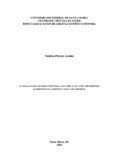| dc.contributor.advisor | Prado, Ana Lucia Cervi | |
| dc.creator | Azolin, Valéria Prestes | |
| dc.date.accessioned | 2017-08-08T12:21:00Z | |
| dc.date.available | 2017-08-08T12:21:00Z | |
| dc.date.issued | 2016-08-25 | |
| dc.date.submitted | 2016 | |
| dc.identifier.uri | http://repositorio.ufsm.br/handle/1/11317 | |
| dc.description | Monografia (especialização) - Universidade Federal de Santa Maria, Centro de Ciências da Saúde, Curso de Especialização em Reabilitação Físico-Motora, RS, 2016. | por |
| dc.description.abstract | Introduction: The stroke is a neurological disorder that affects the hemisphere contralateral to the lesion and causes asymmetry in weight distribution between hemibodies and consequent difficulty in postural control. The functional differences between the cerebral hemispheres originate distinct characteristic in this postural control and this should be considered in the physical therapy treatments. Objective: To establish relationship between the postural control and the impaired hemisphere in stroke. Methods: Descriptive study, cross case, with a qualitative and quantitative approach. The sample consisted of 8 subjects, divided into two groups, group with lesions in the right hemisphere (HCD) and the group left hemisphere lesion (HCE), equated by sex and age. They were used: Patient’s Registration Form, Berg Balance Scale (BBS), Trunk Disability Scale (TDS) and Timed Up and Go (TUG). The sample characterization data and the variables analyzed in postural control tests were treated using descriptive statistics, using Excel 2013 software. Results: We included 8 subjects as the participants. Although the results does not allow infer statistically significant difference, it seems there is evidence that individuals with affected HCD, have greater difficulty in postural control in relation to subjects with injury in HCE. Conclusion: In the present study, subjects with injury HCD had higher scores than the ones with the HCE affected. This suggests that these individuals have higher deficits in postural control, reflecting on their activities of daily living and on the adoption of a suitable physical therapy treatment. | eng |
| dc.language | por | por |
| dc.publisher | Universidade Federal de Santa Maria | por |
| dc.rights | Acesso Aberto | por |
| dc.rights | Attribution-NonCommercial-NoDerivatives 4.0 International | * |
| dc.rights.uri | http://creativecommons.org/licenses/by-nc-nd/4.0/ | * |
| dc.subject | AVC (Acidente Vascular Cerebral) | por |
| dc.subject | Controle postural | por |
| dc.subject | Hemisfério cerebral | por |
| dc.subject | Stroke | eng |
| dc.subject | Cerebral hemisphere | eng |
| dc.subject | Postural control | eng |
| dc.title | Avaliação do controle postural e sua relação com o hemisfério acometido no acidente vascular cerebral | por |
| dc.title.alternative | Postural control evaluation and its relationship with the impaired hemisphere in stroke | eng |
| dc.type | Trabalho de Conclusão de Curso de Especialização | por |
| dc.degree.local | Santa Maria, RS, Brasil. | por |
| dc.degree.specialization | Reabilitação Físico-Motora | por |
| dc.description.resumo | Introdução: O Acidente Vascular Cerebral (AVC) é uma perturbação neurológica que compromete o hemicorpo contralateral a lesão e ocasiona assimetria com distribuição de peso entre os hemicorpos e consequente dificuldade no controle postural. As diferenças funcionais entre os hemisférios cerebrais originam características distintas neste controle postural e isso deve ser observado nos tratamentos fisioterapêuticos. Objetivo: Relacionar o controle postural com o hemisfério acometido no AVC. Metodologia: Pesquisa descritiva, transversal do tipo estudo de caso com abordagem quali-quantitativa. A amostra foi composta por 8 sujeitos, divididos em dois grupos, grupo com lesão no hemisfério cerebral direito (HCD) e grupo lesão hemisfério cerebral esquerdo (HCE), equiparados por sexo e idade. Foram utilizados: Ficha de Registro dos Pacientes, Escala de Equilíbrio de Berg (EEB), Escala de Deficiência de Tronco (EDT) e Timed Up andGo (TUG). Os dados de caracterização da amostra e as variáveis analisadas nos testes de controle postural foram tratadas por meio estatística descritiva, usando o software Excel 2013. Resultados: Foram incluídos 8 sujeitos participantes do grupo. Embora os resultados não permitam inferir diferença estatisticamente significativa, parece haver evidências de que sujeitos com HCD afetado, apresentam maior dificuldade no controle postural em relação a sujeitos com lesão no HCE.Conclusão: No presente estudo indivíduos com lesão no HCD tiveram escores maiores que os do HCE, isso sugere que esses indivíduos tem maiores déficits de controle postural repercutindo sobre as suas atividades de vida diária e também na escolha de um tratamento fisioterapêutico adequado. | por |
| dc.publisher.country | Brasil | por |
| dc.publisher.initials | UFSM | por |
| dc.subject.cnpq | CNPQ::CIENCIAS DA SAUDE | por |
| dc.publisher.unidade | Centro de Ciências da Saúde | por |



